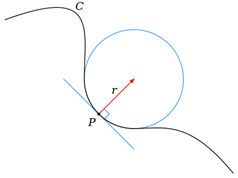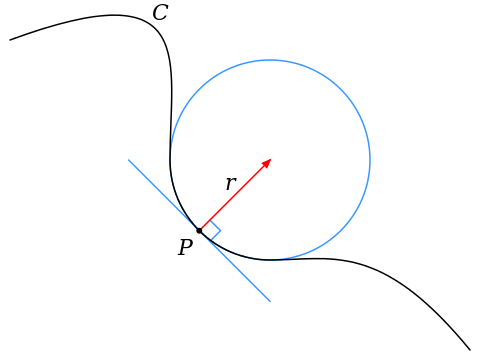[Martin Taylor 2016.09.13.
I said that we had tried "sic ways from Sunday" to get across the
same point. Thanks for pointing the way to a “Sunday version”.
These formulas are correct when used in the way G+O used them. But
they do tend to lead one astray when the context becomes more
general. As I said very early in the thread, it’s a very easy
mistake to make.
What's wrong with plugging the value of V from (8) into the equation
for R (9)? Nothing, if all you want to do, as is the case for G+O,
is to compute the curvature at a point where the observed velocity
was V, which they computed from (8). It’s fine, because you can use
any value of V at all in (9). What you can’t do is work backwards
from (9) to generate a specific value of V. It’s a subtle variant of
the “divide by zero” error.
A crude version of the "divide by zero" error goes like this:
x/a = w
y/a = z
If w = z, then x = y
x/0 = infinity
3/0 = infinity
infinity = infinity
Hence x = 3
but also
x/0 = infinity
4/0 = infinity
Hence x = 4, but since also x = 3, therefore 3 = 4.
The problem there is that infinity*c = infinity for all c, so the
original “if-then” statement is wrong. It should read “If (w = z AND
w != 0) then x = y”. Most times, the “divide by zero” error occurs
much more subtly and is often hard to find in a convoluted proof
that is actually wrong despite looking formally correct.
What you have in the G+O pair of equations is a similar situation,
though the problem is compounded by a perceptual problem in the
notation, which is Newton’s “dotty” rather than Leibnits’s explicit
notation. Typically we use the dot notation to specify
differentiation with respect to time. If the variable being
differentiated is a spatial extent, then the first derivative is a
velocity in the direction represented by that variable and the
second derivative is an acceleration in the same direction. That’s
what Newton wanted for his planetary orbits and falling apples, and
that’s what G+O wanted in order to measure the along-track velocity
pattern of their moving object (finger, I guess, though the paper
isn’t explicit). They didn’t have an accelerometer attached to the
finger, but they could handily determine its position in x and y,
and Euclid allowed them to compute the along-track velocity and
acceleration by taking the square root of the sum of squares. That
gave them equation (8).
Now we have to see how they came to equation (9). That's a bit more
complicated, so please bear with me.
They presumably either used someone else's derivation or made their
own, starting from one of several equivalent measures of curvature,
one of which is C = 1/R where R is the radius of the osculating
circle at the point of concern. Another one is developed using
vector calculus, which I have no intention of introducing into this
discussion. It is C = dx/ds*d2y/ds2 - dy/ds *
d2x/ds2 , where s is distance along the curve
from some arbitrary starting point.
For G+O this formula was not very convenient, because they would
have had to measure these first and second derivatives of x and y
with respect to distance along the curve fairly accurately. But they
had a trick available, in the “chain rule” of differentiation:
dx/dydy/dz = dx/dz. The "dy"s cancel out just like ordinary
variables. Using the chain rule on the first derivative gives you
the rule for the second derivative, and so on. For the second
derivative the rule is (d2x/dy2)(dy/dz)2
= d2x/dz2.
Using the chain rule, G+O could multiply the formula for C by
(ds/dz}3/(ds/dz)3 = 1, for any variable z that
allowed the differentiation, to get C = ((dx/ds)(ds/dz)(d2y/ds2)(ds/dz)2)(ds/dz)3
- (dy/ds)(ds/dz)(d2x/ds2)*(ds/dz)3)/(ds/dz)3 .
This formula is true (allowing for typos) for variable “z” whatever
(as with the divide by zero example), but it wouldn’t have helped
G+O very much, had it not been that for one particular variable they
already had measures they could use. Those measures were the ds/dt
velocity and the derived d2s/dt2 values they
had obtained from their observations of movement. Using those
measures, they could set “z” = t (time), making dx/dt =
dx/ds*ds/dt. They could then take advantage of their measured
velocities to substitute for ds/dt, and write
C = (dx/dt*d<sup>2</sup>y/dt<sup>2</sup>)/V<sup>3</sup> - (dy/dt*d<sup>2</sup>y/dt<sup>2</sup>)/V<sup>3</sup>
Oh goody! We don't have to measure anything new to get our
curvatures. We can use the values of dx/dt and dy/dt that we got
before! Very handy. … But also very confusing, because it made the
published equations look as though the V3/V3
multiplier was special to the velocities they measured, whereas it
was simply a convenient choice from a literally infinite variety of
choices they could have made. G+O made it even more confusing in the
publication by using the Newton dotty notation, which made it look
as though there was something necessary about the time
differentiation in the curvature equation.
When we put all this together, we come to the way this is a variant
of the “divide by zero” error. That error depends on the fact that
you can put any variable at all in for “x” in “x/0 = infinity”. The
– shall we call it – the “curvature error” depends on the fact
that you can use anything at all for V (including the measured
values), provided only that V is defined as ds/dz where z is some
variable for which ds/dz exists everywhere. You therefore cannot use
the curvature equation in any way to determine V.
Does this "Sunday" explanation help?
Martin

···
[From Rick Marken (2016.09.12.1750)]
Martin Taylor (2016.09.12.12.15) –
MT: In my view, Rick is a great experimenter and
producer of lovely demos of PCT, but he is no
mathematician and no theorist.
To allow his idiosyncratic private
theories of mathematical relationships to stand as
though they were acceptable would be simply
irresponsible.
RM: OK, let's
try this again slowly so you can show me where my
mistake is. Let’s start by making sure that I’m using
the right equations. Here are the two equations from
Gribble, P. L., & Ostry, D. J. (1996). Origins of
the
power law relation between movement velocity and
curvature: modeling the
effects of muscle mechanics and limb dynamics. J* ournal
of Neurophysiology* ,
76(5), 2853-2860 that define the variables V and R that
are going to be used in the analysis to see if the
relatoiship between them fits the power law.
RM: Do you agree that these are the formulas for computing V
and R or is this paper the wrong reference to use for those
formulas?


